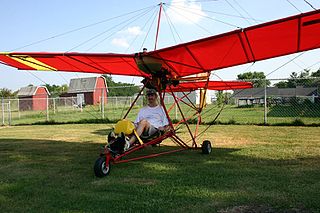
The Aero Adventure Aventura is a family of ultralight amphibians marketed as a kit aircraft by Aero Adventure of DeLand, Florida. The aircraft was designed by Bob Bailey in 1995.

Quicksilver is a line of single and two-place high wing, single-engine, ultralight aircraft that evolved from weight-shift hang gliders including Bob Lovejoy's High Tailer.

The Murphy Rebel is a two- or three-seat, strut braced, high wing, taildragger monoplane which is sold in kit form by Murphy Aircraft in Chilliwack, British Columbia, Canada.

The Fisher FP-404 is a Canadian single-seat, conventional landing gear, single-engined biplane kit aircraft designed for construction by amateur builders. Fisher Flying Products was originally based in Edgeley, North Dakota, USA but the company is now located in Woodbridge, Ontario, Canada.

The Fisher Celebrity is a Canadian two-seat, conventional landing gear, single engined, biplane kit aircraft designed for construction by amateur builders. Fisher Flying Products was originally based in Edgeley, North Dakota, United States but the company is now located in Dorchester, Ontario, Canada.

The Fisher Classic is a Canadian two-seat, conventional landing gear, single-engined, biplane kit aircraft designed for construction by amateur builders. The aircraft is a two-seat derivation of the Fisher FP-404. Fisher Flying Products was originally based in Edgeley, North Dakota, USA but the company is now located in Woodbridge, Ontario, Canada.
The Fisher Youngster is a Canadian single-seat, conventional landing gear, single-engined, biplane kit aircraft designed for construction by amateur builders. The aircraft was inspired by the German Bücker Bü 133 Jungmeister aerobatic aircraft of the 1930s.

The Fisher Dakota Hawk is a Canadian side-by-side two-seat, conventional landing gear, single-engined, high-wing monoplane kit aircraft designed for construction by amateur builders.

The Murphy JDM-8 is a Canadian single-seat ultralight monoplane designed by Daryl Murphy. The type was intended to be sold as a kit for home construction by Murphy Aircraft of Chilliwack, British Columbia.

The Sorrell Hiperlight is a family of single and two seat, negative stagger biplanes, designed for amateur construction.
The Kolb Kolbra and King Kolbra are a family of American tandem two seater, high wing, strut-braced, pusher configuration, conventional landing gear-equipped ultralight aircraft that are produced in kit form by New Kolb Aircraft of London, Kentucky and intended for amateur construction.

The RagWing RW2 Special I is a family of biplane, single engine homebuilt aircraft designed by Roger Mann and sold as plans by RagWing Aircraft Designs for amateur construction.
The Rocky Mountain Wings Ridge Runner is a family of American high wing, strut-braced, single engine, conventional landing gear aircraft that were designed by Stace Schrader and were produced by Rocky Mountain Wings of Nampa, Idaho for amateur construction from 2000 to 2018.
The Flying K Sky Raider is a family of American, high wing, strut-braced, single engine, conventional landing gear ultralight aircraft that was designed by Ken Schrader and produced by Flying K Enterprises and later Sky Raider LLC of Caldwell, Idaho for amateur construction.
The Loehle SPAD XIII is a family of American single-seat, biplane, conventional landing gear, single engine, ultralight aircraft produced in kit form by Loehle Aircraft for amateur construction. The aircraft meets the requirements of the US FAR 103 Ultralight Vehicles regulations when equipped with a lightweight engine.

The Carlson Sparrow is a family of American, high wing, strut-braced, single engine, ultralight aircraft that was designed by Ernst W. Carlson and produced by Carlson Aircraft of East Palestine, Ohio and later Skyline Technologies of Salem, Ohio for amateur construction.

The Raj Hamsa X-Air is an Indian, two-seat, high-wing, tricycle gear, tractor configuration, ultralight aircraft produced by Raj Hamsa Ultralights of Bangalore, Karnataka in kit form, for amateur construction.
The Howland H-3 Pegasus is an American ultralight aircraft that was designed by Bert Howland and made available by Howland Aero Design in the form of plans for amateur construction, with kits provided by Aircraft Spruce & Specialty Co. The H-3 first flew in 1988.
The Anglin J6 Karatoo is an Australian ultralight and light-sport aircraft that was designed by Jessie Anglin and introduced in 1982. Over the years the J6 Karatoo has been produced by several different manufacturers, including Amax Engineering of Donvale, Victoria, Skyway Aircraft and is currently built by Serenity Aviation of Australia. The aircraft is supplied as plans or as a kit for amateur construction.
The Acrolite is a family of Canadian amateur-built aircraft, designed by Ron Wilson and produced by Acrolite Aircraft of Kakabeka Falls, Ontario, in the form of plans for amateur construction.















